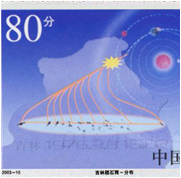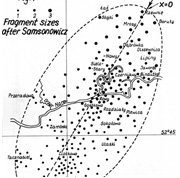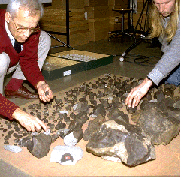Grab Your Umbrellas!

Enlargement
After a meteoroid breaks up, the largest fragments travel a little farther because they have greater momentum. This stamp depicts the shower in Jilin, China. |
When a meteoroid enters the Earth's atmosphere, it is subjected to enormous stress. This is due to the difference in pressure at the front and the back of the object and the differences in temperature between its surface and its core. Large stony meteoroids do not hold up well to these stresses and break easily.
Fragmentation takes place at low altitude, and the fragments fall together to the ground, forming an ellipse. The largest fragments are usually found at the front of the ellipse and indicate the direction of the fall. A shower can total several tens, hundreds, or thousands of fragments. After a shower rained down on the village of Pultusk in Poland in January 1875, more than 100,000 fragments were recovered! Besides showers from the fragmentation of one meteoroid, multiple falls can be caused by meteoroids travelling together in space.
| SOME IMPORTANT METEOR SHOWERS |
| Name |
Country |
Year |
Number of fragments |
| Allende |
Mexico |
1969 |
Thousands |
| Sikhote-Alin |
Russia |
1947 |
Thousands |
| Pultusk |
Poland |
1868 |
Between 100,000 and 300,000 |
| Holbrook |
United States |
1912 |
16,000 |
| L'Aigle |
France |
1803 |
Between 2,000 and 3,000 |
| Bruderheim |
Canada |
1960 |
700 |
| Homestead |
United States |
1875 |
100 |
 |
| Enlargement |
| Fragments from the Pultusk meteorite in Poland, spread out in an ellipse measuring 8 kilometres by 1.6 kilometres. |
 |
| Enlargement |
| Fragments from the shower in Mbale, Uganda, vary in size from 0.1 gram to 27.4 kilograms. |
Fragmentation of the Peekskill meteoroid captured on video by a spectator at a football game.
© O. Shinfineld, Halifax, Virginia
|